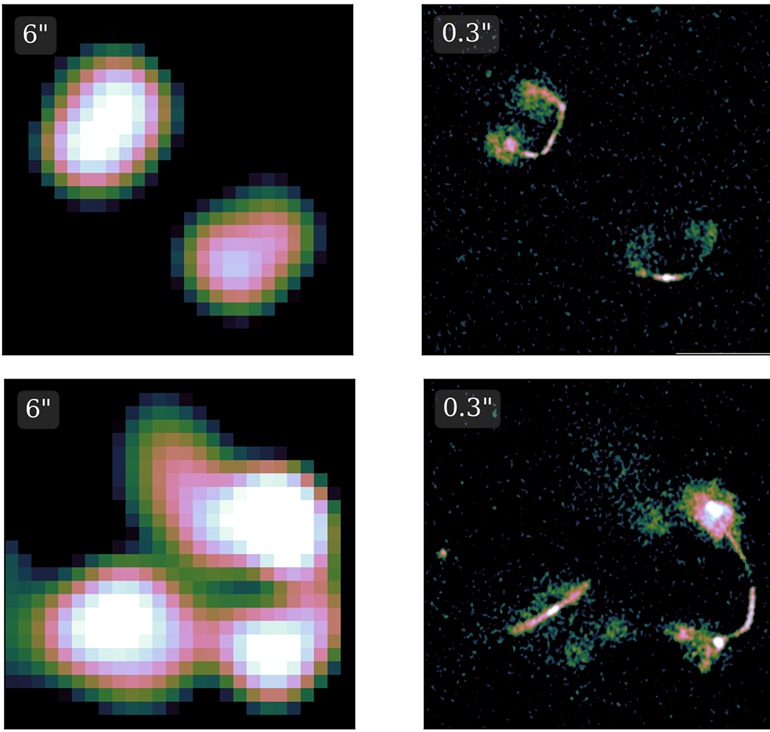
28 Mar 2025
The Dutch Research Council (NWO) has awarded over €4.6 million to ASTRON, the Netherlands Institute for Radio Astronomy, for a major upgrade to the Low-Frequency Array (LOFAR) radio telescope. The project, called LOFAR Enhanced Network for Sharp Surveys (LENSS), will significantly increase LOFAR’s observational capabilities, enabling astronomers to view four times more of the sky simultaneously while producing images with unprecedented clarity.
“This upgrade will transform LOFAR into an even more powerful tool for exploring the Universe,” said Prof. Dr. Jessica Dempsey, Director of ASTRON and project lead. “We’ll be able to observe wider areas of the sky with exceptional detail, all while maintaining our commitment to sustainable, energy-efficient operations.”
LENSS represents a significant technological advancement in radio astronomy, with improvements focused on:
- Expanding LOFAR’s field-of-view from 12 to 50 degrees of sky
- Achieving a resolution 20 times sharper using the full 2000 km baseline of antennas
- Processing observations 40 times faster, turning weeks of computing into hours
- Maintaining the same energy footprint despite these dramatic improvements
“These enhancements will enable astronomers to study cosmic phenomena with unprecedented detail, from tracking star formation throughout cosmic history to monitoring how exoplanets interact with their host stars, and capturing rare cosmic events like merging neutron stars,” said Prof. Dr. André Offringa, head of the LOFAR Science Group at ASTRON.
The LENSS project builds strategically upon the foundation laid by the ongoing LOFAR 2.0 upgrade. While LOFAR 2.0 focuses on hardware enhancements at the antenna stations—enabling all antennas to operate simultaneously and observe in both low and high frequencies—LENSS addresses the next critical bottleneck: the network and processing capacity needed to handle this dramatically increased data flow.
“LENSS exemplifies how we can extract maximum scientific value from existing infrastructure through strategic upgrades,” said Roelien Attema, head of Research & Development at ASTRON. “This project aligns perfectly with our mission to support innovative research infrastructure that enables breakthrough science.”
“The technological innovations being developed for LENSS have implications far beyond astronomy,” added Prof. Dempsey. “As one of the first research infrastructures to tackle the challenges of processing such massive data volumes efficiently and carbon-neutrally, the solutions we develop will provide valuable insights for other data-intensive fields facing similar challenges, from climate science to medical imaging. LENSS positions the Netherlands as a pioneer in sustainable big data processing techniques that will become increasingly crucial across many domains of science and society.”
The project involves a consortium of partners including ASTRON, the LOFAR European Research Infrastructure Consortium (ERIC), multiple Dutch universities, and international research organisations, bringing together expertise in astronomy, computing, signal processing, and data management. The NWO grant of €4.6 million will be supplemented by €1.6 million in eligible contributions from consortium partners.
The LENSS project is scheduled for completion over the next five years, with the enhanced telescope expected to be fully operational by 2029.
[Image]
Comparison between the current standard LOFAR resolution (left) and LOFAR’s highest available resolution (right). This figure provides examples illustrating how the highest resolution can be essential for identifying and studying radio jets launched from regions near the central black holes of distant galaxies. LENSS will enable LOFAR to survey the entire Northern sky at this highest resolution, unlocking a wealth of scientific opportunities.
